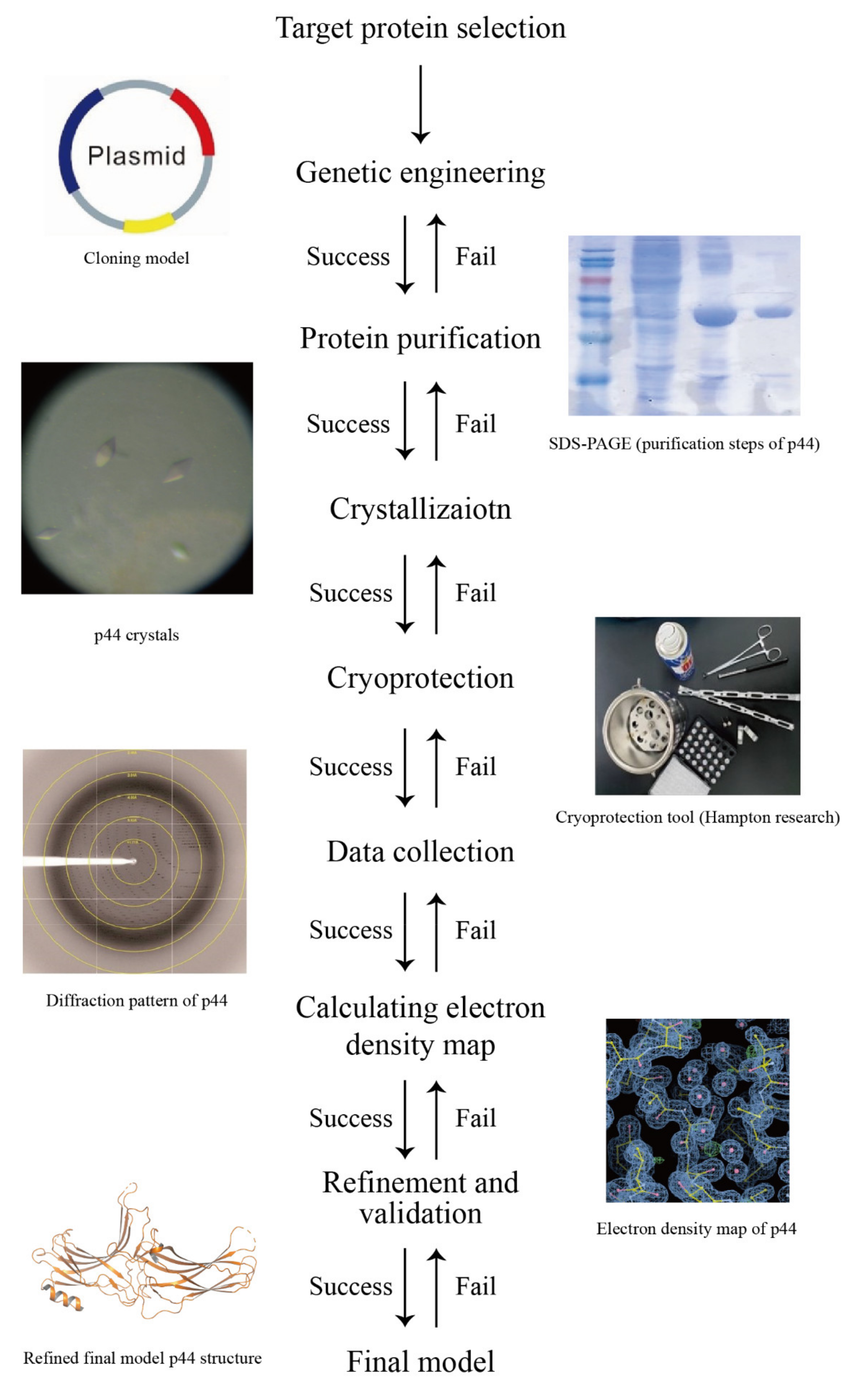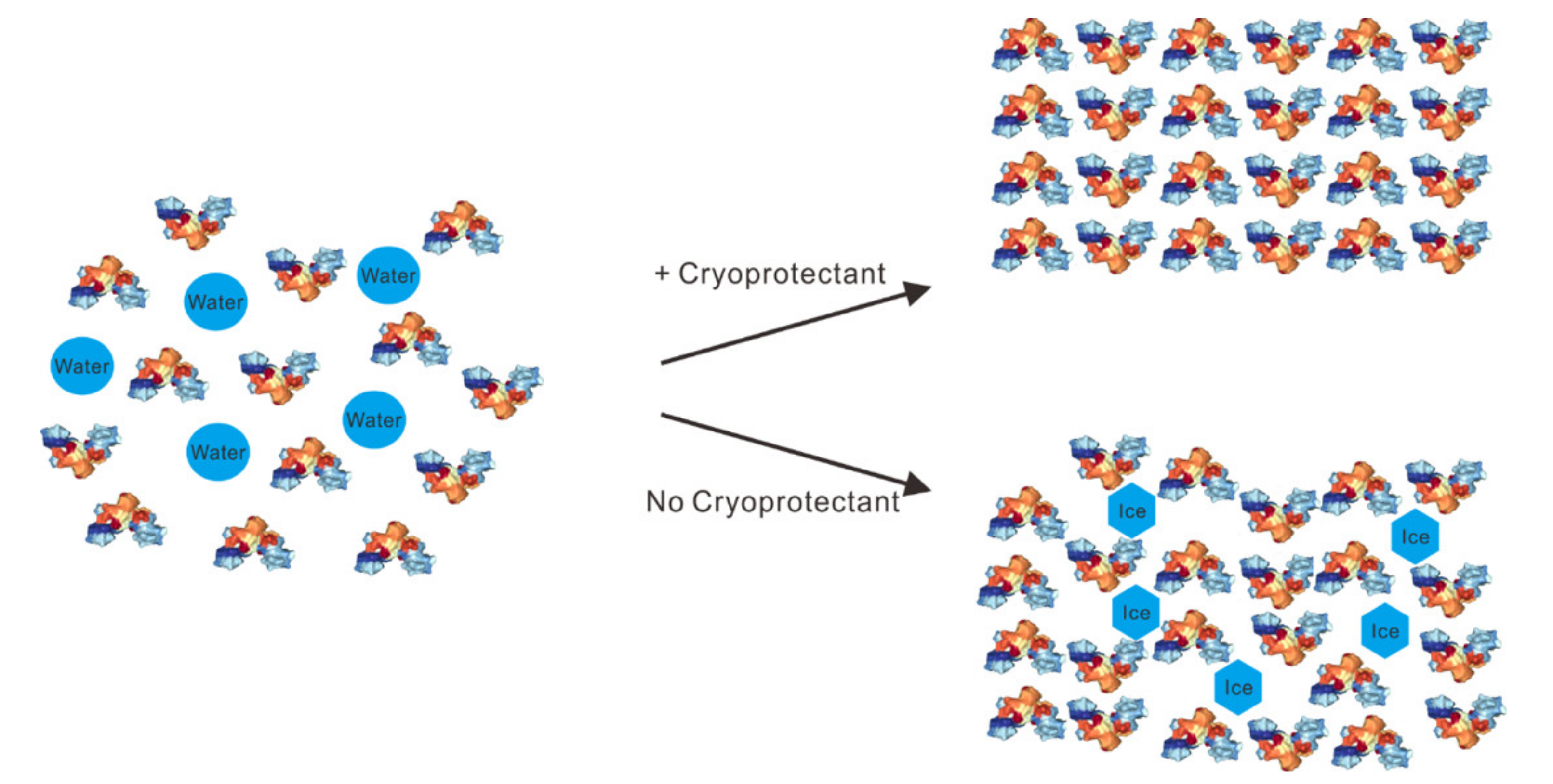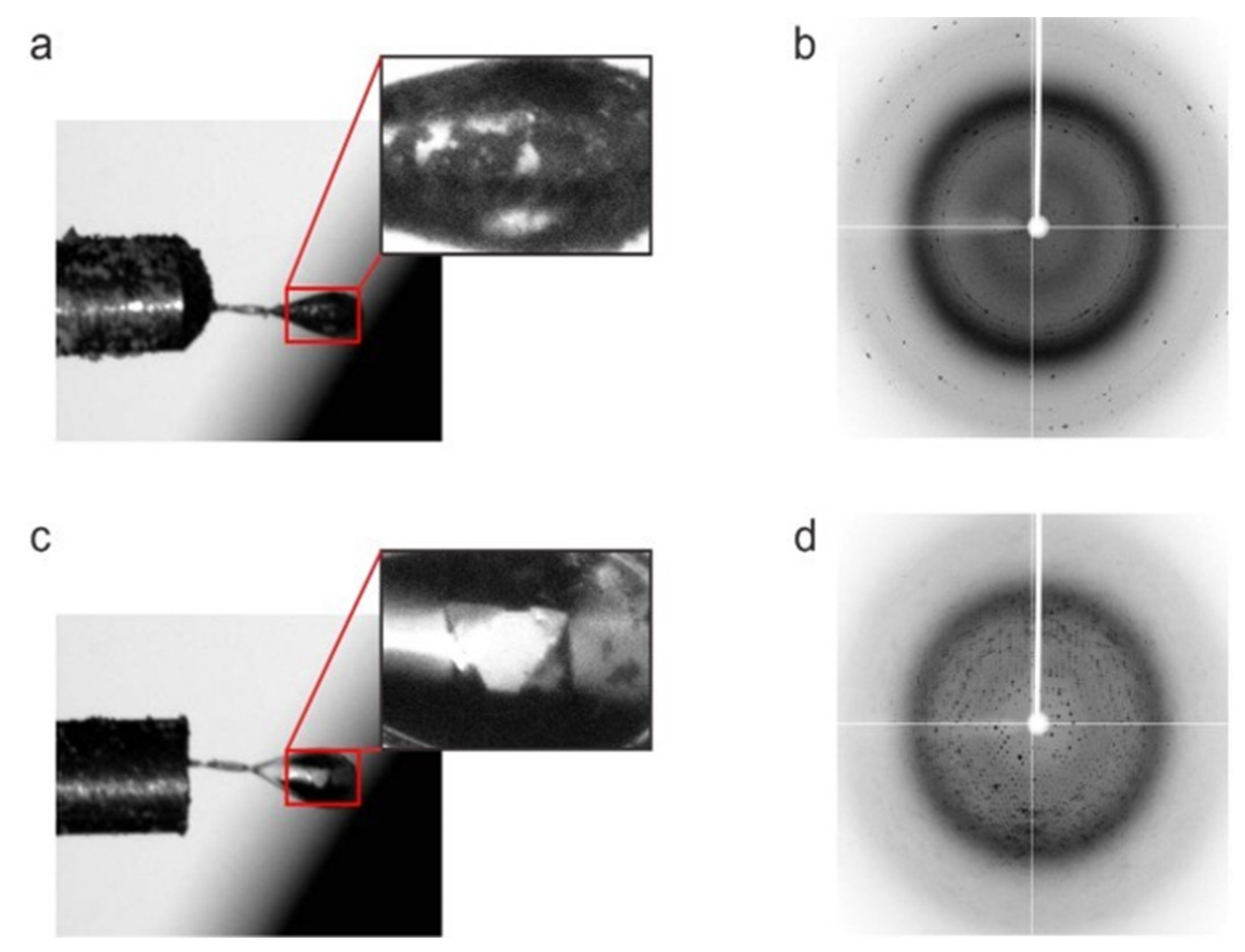A Short Review on Cryoprotectants for 3D Protein Structure Analysis
Abstract
:1. Introduction
2. What Is Cryoprotection, and When Do We Use Cryoprotectants?
3. X-ray Damage and Diffraction Quality
4. How to Improve the Diffraction Quality of Protein Crystal?
5. The Problem in Structural Analysis
6. Conclusions
Supplementary Materials
Author Contributions
Funding
Institutional Review Board Statement
Informed Consent Statement
Data Availability Statement
Acknowledgments
Conflicts of Interest
References
- Funke, O. Über das Milzvenenblut. Z. Rat. Med. 1851, 1, 172–179. [Google Scholar]
- Hunefeld, F. Die Chemismus in der Thierischen Organization; Brockhaus: Leipzig, Germany, 1840; pp. 158–163. [Google Scholar]
- Ritthausen, H. Über die Eiweisskorper verschiedenen Oelsamen. Pfluegers Arch. 1880, 21, 81–104. [Google Scholar] [CrossRef]
- Osborne, T. The proteids of the Brazil nut. Am. Chem. J. 1891, 13, 212–218. [Google Scholar]
- Protein Data Bank. Protein data bank. Nat. New Biol. 1971, 233, 233. [Google Scholar]
- wwPDB Consortium. Protein Data Bank: The single global archive for 3D macromolecular structure data. Nucleic Acids Res. 2018, 47, D520–D528. [Google Scholar]
- Kim, Y.J.; Hofmann, K.P.; Ernst, O.P.; Scheerer, P.; Choe, H.-W.; Sommer, M.E. Crystal structure of pre-activated arrestin p44. Nature 2013, 497, 142–146. [Google Scholar] [CrossRef]
- Heras, B.; Martin, J.L. Post-crystallization treatments for improving diffraction quality of protein crystals. Acta Crystallogr. Sect. D Biol. Crystallogr. 2005, 61, 1173–1180. [Google Scholar] [CrossRef] [Green Version]
- Chayen, N.E.; Saridakis, E. Protein crystallization: From purified protein to diffraction-quality crystal. Nat. Methods 2008, 5, 147–153. [Google Scholar] [CrossRef]
- Garman, E.F.; Owen, R.L. Cryocooling and radiation damage in macromolecular crystallography. Acta Crystallogr. Sect. D Biol. Crystallogr. 2006, 62, 32–47. [Google Scholar] [CrossRef] [Green Version]
- Pflugrath, J.W. Practical macromolecular cryocrystallography. Acta Cryst. F Struct. Biol. Commun. 2015, 71, 622–642. [Google Scholar] [CrossRef]
- Kriminski, S.; Caylor, C.L.; Nonato, M.C.; Finkelstein, K.D.; Thorne, R.E. Flash-cooling and annealing of protein crystals. Acta Crystallogr. Sect. D Biol. Crystallogr. 2002, 58, 459–471. [Google Scholar] [CrossRef] [PubMed] [Green Version]
- Maleknia, S.D.; Ralston, C.Y.; Brenowitz, M.D.; Downard, K.M.; Chance, M.R. Determination of macromolecular folding and structure by synchrotron x-ray radiolysis techniques. Anal. Biochem. 2001, 289, 103–115. [Google Scholar] [CrossRef]
- O’Neill, P.; Stevens, D.L.; Garman, E. Physical and chemical considerations of damage induced in protein crystals by synchrotron radiation: A radiation chemical perspective. J. Synchrotron Radiat. 2002, 9, 329–332. [Google Scholar] [CrossRef] [PubMed] [Green Version]
- Xiao, B.; Gamblin, S.J. The effects of cryoprotectant on crystal stability. J. Cryst. Growth 1996, 168, 244–247. [Google Scholar] [CrossRef]
- Garman, E. Cool data: Quantity AND quality. Acta Crystallogr. Sect. D Biol. Crystallogr. 1999, 55, 1641–1653. [Google Scholar] [CrossRef] [PubMed] [Green Version]
- Petock, J.M.; Wang, Y.-F.; DuBois, G.C.; Harrison, R.W.; Weber, I.T. Effects of different post-crystallization soaking conditions on the diffraction of Mtcp1 crystals. Acta Crystallogr. Sect. D Biol. Crystallogr. 2001, 57, 763–765. [Google Scholar] [CrossRef] [PubMed] [Green Version]
- Walker, L.J.; Moreno, P.O.; Hope, H. Cryocrystallography: Effect of cooling medium on sample cooling rate. J. Appl. Crystallogr. 1998, 31, 954–956. [Google Scholar] [CrossRef] [Green Version]
- Vera, L.; Stura, E.A. Strategies for protein cryocrystallography. Cryst. Growth Des. 2013, 14, 427–435. [Google Scholar] [CrossRef]
- López-Jaramillo, F.; Moraleda, A.; González-Ramírez, L.; Carazo, A.; García-Ruiz, J. Soaking: The effect of osmotic shock on tetragonal lysozyme crystals. Acta Crystallogr. Sect. D Biol. Crystallogr. 2002, 58, 209–214. [Google Scholar] [CrossRef] [Green Version]
- Anand, K.; Pal, D.; Hilgenfeld, R. An overview on 2-methyl-2, 4-pentanediol in crystallization and in crystals of biological macromolecules. Acta Crystallogr. Sect. D Biol. Crystallogr. 2002, 58, 1722–1728. [Google Scholar] [CrossRef]
- Vera, L.; Czarny, B.; Georgiadis, D.; Dive, V.; Stura, E.A. Practical use of glycerol in protein crystallization. Cryst. Growth Des. 2011, 11, 2755–2762. [Google Scholar] [CrossRef]
- Farley, C.; Juers, D.H. Efficient cryoprotection of macromolecular crystals using vapor diffusion of volatile alcohols. J. Struct. Biol. 2014, 188, 102–106. [Google Scholar] [CrossRef] [Green Version]
- Garman, E.F.; Doublié, S. Cryocooling of macromolecular crystals: Optimization methods. Methods Enzymol. 2003, 368, 188–216. [Google Scholar]
- Alcorn, T.; Juers, D.H. Progress in rational methods of cryoprotection in macromolecular crystallography. Acta Crystallogr. Sect. D Biol. Crystallogr. 2010, 66, 366–373. [Google Scholar] [CrossRef] [PubMed] [Green Version]
- Nave, C. Radiation damage in protein crystallography. Radiat. Phys. Chem. 1995, 45, 483–490. [Google Scholar] [CrossRef]
- Henderson, R. Cryo-protection of protein crystals against radiation damage in electron and X-ray diffraction. Proc. R. Soc. Lond. Ser. B Biol. Sci. 1990, 241, 6–8. [Google Scholar]
- Moffat, K.; Bilderback, D.; Schildkamp, W.; Volz, K. Laue diffraction from biological samples. Nucl. Instrum. Methods Phys. Res. Sect. A Accel. Spectrometers Detect. Assoc. Equip. 1986, 246, 627–635. [Google Scholar] [CrossRef]
- Moffat, K. Time-resolved macromolecular crystallography. Annu. Rev. Biophys. Biophys. Chem. 1989, 18, 309–332. [Google Scholar] [CrossRef] [PubMed]
- Getzoff, E.; Jones, K.; McRee, D.; Moffat, K.; Ng, K.; Rivers, M.; Schildkamp, W.; Singer, P.; Spanne, P.; Sweet, R. Laue diffraction protein crystallography at the National Synchrotron Light Source. Nucl. Instrum. Methods Phys. Res. Sect. B Beam Interact. Mater. At. 1993, 79, 249–255. [Google Scholar] [CrossRef] [Green Version]
- Gonzalez, A.; Nave, C. Radiation damage in protein crystals at low temperature. Acta Crystallogr. Sect. D Biol. Crystallogr. 1994, 50, 874–877. [Google Scholar] [CrossRef] [PubMed]
- Alkire, R.; Rotella, F.; Duke, N. Testing commercial protein crystallography sample mounting loops for movement in a cold-stream. J. Appl. Crystallogr. 2013, 46, 525–536. [Google Scholar] [CrossRef]
- Berger, M.A.; Decker, J.H.; Mathews, I.I. Diffraction study of protein crystals grown in cryoloops and micromounts. J. Appl. Crystallogr. 2010, 43, 1513–1518. [Google Scholar] [CrossRef] [PubMed] [Green Version]
- Aggarwal, M.; Boone, C.D.; Kondeti, B.; Tu, C.; Silverman, D.N.; McKenna, R. Effects of cryoprotectants on the structure and thermostability of the human carbonic anhydrase II–acetazolamide complex. Acta Crystallogr. Sect. D Biol. Crystallogr. 2013, 69, 860–865. [Google Scholar] [CrossRef] [Green Version]
- Teng, T.Y.; Moffat, K. Primary radiation damage of protein crystals by an intense synchrotron X-ray beam. J. Synchrotron Radiat. 2000, 7, 313–317. [Google Scholar] [CrossRef]
- Harp, J.M.; Timm, D.E.; Bunick, G.J. Macromolecular crystal annealing: Overcoming increased mosaicity associated with cryocrystallography. Acta Crystallogr. Sect. D Biol. Crystallogr. 1998, 54, 622–628. [Google Scholar] [CrossRef] [PubMed]
- Yeh, J.I.; Hol, W.G. A flash-annealing technique to improve diffraction limits and lower mosaicity in crystals of glycerol kinase. Acta Crystallogr. Sect. D Biol. Crystallogr. 1998, 54, 479–480. [Google Scholar] [CrossRef] [PubMed] [Green Version]
- Harp, J.M.; Hanson, B.L.; Timm, D.E.; Bunick, G.J. Macromolecular crystal annealing: Evaluation of techniques and variables. Acta Crystallogr. Sect. D Biol. Crystallogr. 1999, 55, 1329–1334. [Google Scholar] [CrossRef] [PubMed]
- Heras, B.; Edeling, M.A.; Byriel, K.A.; Jones, A.; Raina, S.; Martin, J.L. Dehydration converts DsbG crystal diffraction from low to high resolution. Structure 2003, 11, 139–145. [Google Scholar] [CrossRef]
- Cramer, P.; Müller, C.W. Engineering of diffraction-quality crystals of the NF-κB P52 homodimer: DNA complex. FEBS Lett. 1997, 405, 373–377. [Google Scholar] [CrossRef] [Green Version]
- Pang, S.S.; Guddat, L.W.; Duggleby, R.G. Crystallization of the FAD-independent acetolactate synthase of Klebsiella pneumoniae. Acta Crystallogr. Sect. D Biol. Crystallogr. 2002, 58, 1237–1239. [Google Scholar] [CrossRef] [PubMed] [Green Version]
- Kodandapani, R.; Vijayan, M. Protein hydration and water structure: X-ray analysis of a closely packed protein crystal with very low solvent content. Acta Crystallogr. Sect. D Biol. Crystallogr. 1993, 49, 234–245. [Google Scholar]
- Dobrianov, I.; Kriminski, S.; Caylor, C.; Lemay, S.; Kimmer, C.; Kisselev, A.; Finkelstein, K.; Thorne, R. Dynamic response of tetragonal lysozyme crystals to changes in relative humidity: Implications for post-growth crystal treatments. Acta Crystallogr. Sect. D Biol. Crystallogr. 2001, 57, 61–68. [Google Scholar] [CrossRef] [Green Version]
- Fu, Z.-Q.; Du Bois, G.C.; Song, S.P.; Harrison, R.W.; Weber, I.T. Improving the diffraction quality of MTCP-1 crystals by post-crystallization soaking. Acta Crystallogr. Sect. D Biol. Crystallogr. 1999, 55, 5–7. [Google Scholar] [CrossRef]
- Izard, T.; Sarfaty, S.; Westphal, A.; De Kok, A.; Hol, W.G. Improvement of diffraction quality upon rehydration of dehydrated icosahedral Enterococcus faecalis pyruvate dehydrogenase core crystals. Protein Sci. 1997, 6, 913–915. [Google Scholar] [CrossRef] [Green Version]
- Sousa, R. Use of glycerol, polyols and other protein structure stabilizing agents in protein crystallization. Acta Crystallogr. Sect. D Biol. Crystallogr. 1995, 51, 271–277. [Google Scholar] [CrossRef] [PubMed]
- Senda, M.; Hayashi, T.; Hatakeyama, M.; Takeuchi, K.; Sasaki, A.T.; Senda, T. Use of multiple cryoprotectants to improve diffraction quality from protein crystals. Cryst. Growth Des. 2016, 16, 1565–1571. [Google Scholar] [CrossRef]
- Kim, C.U.; Kapfer, R.; Gruner, S.M. High-pressure cooling of protein crystals without cryoprotectants. Acta Crystallogr. Sect. D Biol. Crystallogr. 2005, 61, 881–890. [Google Scholar] [CrossRef] [PubMed] [Green Version]
- Kim, C.U.; Hao, Q.; Gruner, S.M. High-pressure cryocooling for capillary sample cryoprotection and diffraction phasing at long wavelengths. Acta Crystallogr. Sect. D Biol. Crystallogr. 2007, 63, 653–659. [Google Scholar] [CrossRef]
- Kim, C.U.; Wierman, J.L.; Gillilan, R.; Lima, E.; Gruner, S.M. A high-pressure cryocooling method for protein crystals and biological samples with reduced background X-ray scatter. J. Appl. Crystallogr. 2013, 46, 234–241. [Google Scholar] [CrossRef] [PubMed] [Green Version]
- Kuwamoto, S.; Akiyama, S.; Fujisawa, T. Radiation damage to a protein solution, detected by synchrotron X-ray small-angle scattering: Dose-related considerations and suppression by cryoprotectants. J. Synchrotron Radiat. 2004, 11, 462–468. [Google Scholar] [CrossRef]
- Kim, Y.J. A cryoprotectant induces conformational change in glyceraldehyde-3-phosphate dehydrogenase. Acta Cryst. F Struct. Biol. Commun. 2018, 74, 277–282. [Google Scholar] [CrossRef] [PubMed]
- Corradini, D.; Strekalova, E.G.; Stanley, H.E.; Gallo, P. Microscopic mechanism of protein cryopreservation in an aqueous solution with trehalose. Sci. Rep. 2013, 3, 1218. [Google Scholar] [CrossRef] [PubMed]
- Fermani, S.; Trivelli, X.; Sparla, F.; Thumiger, A.; Calvaresi, M.; Marri, L.; Falini, G.; Zerbetto, F.; Trost, P. Conformational selection and folding-upon-binding of intrinsically disordered protein CP12 regulate photosynthetic enzymes assembly. J. Biol. Chem. 2012, 287, 21372–21383. [Google Scholar] [CrossRef] [PubMed] [Green Version]
- Omar Abuzaid, A.; Elena López-Calcagno, P.; Lawson, T.; Anne Raines, C. Arabidopsis CP12 mutants have reduced levels of phosphoribulokinase and impaired function of the Calvin–Benson cycle. J. Exp. Bot. 2017, 68, 2285–2298. [Google Scholar] [CrossRef] [Green Version]
- Skrzypczak-Jankun, E.; Borbulevych, O.; Zavodszky, M.; Baranski, M.; Padmanabhan, K.; Petricek, V.; Jankun, J. Effect of crystal freezing and small-molecule binding on internal cavity size in a large protein: X-ray and docking studies of lipoxygenase at ambient and low temperature at 2.0 Å resolution. Acta Crystallogr. Sect. D Biol. Crystallogr. 2006, 62, 766–775. [Google Scholar] [CrossRef]
- Keedy, D.A.; Van Den Bedem, H.; Sivak, D.A.; Petsko, G.A.; Ringe, D.; Wilson, M.A.; Fraser, J.S. Crystal cryocooling distorts conformational heterogeneity in a model Michaelis complex of DHFR. Structure 2014, 22, 899–910. [Google Scholar] [CrossRef] [Green Version]
- Fischer, M.; Shoichet, B.K.; Fraser, J.S. One crystal, two temperatures: Cryocooling penalties alter ligand binding to transient protein sites. ChemBioChem 2015, 16, 1560. [Google Scholar] [CrossRef] [PubMed] [Green Version]
- Fraser, J.S.; Clarkson, M.W.; Degnan, S.C.; Erion, R.; Kern, D.; Alber, T. Hidden alternative structures of proline isomerase essential for catalysis. Nature 2009, 462, 669–673. [Google Scholar] [CrossRef]
- Maeki, M.; Ito, S.; Takeda, R.; Ueno, G.; Ishida, A.; Tani, H.; Yamamoto, M.; Tokeshi, M. Room-temperature crystallography using a microfluidic protein crystal array device and its application to protein–ligand complex structure analysis. Chem. Sci. 2020, 11, 9072–9087. [Google Scholar] [CrossRef]
- Samygina, V.R.; Antonyuk, S.V.; Lamzin, V.S.; Popov, A.N. Improving the X-ray resolution by reversible flash-cooling combined with concentration screening, as exemplified with PPase. Acta Crystallogr. Sect. D Biol. Crystallogr. 2000, 56, 595–603. [Google Scholar] [CrossRef] [Green Version]
- Rodgers, D.W. Cryocrystallography. Structure 1994, 2, 1135–1140. [Google Scholar] [CrossRef] [Green Version]
- Garman, E.F.; Schneider, T.R. Macromolecular cryocrystallography. J. Appl. Crystallogr. 1997, 30, 211–237. [Google Scholar] [CrossRef] [Green Version]
- Juers, D.H.; Matthews, B.W. Cryo-cooling in macromolecular crystallography: Advantages, disadvantages and optimization. Q. Rev. Biophys. 2004, 37, 105. [Google Scholar] [CrossRef] [PubMed]



| Penetrate | ||||
| Sugars (25~50%) | ||||
| Glucose | Sucrose | Maltose | Xylitol | Inositol |
| Trehalose | Raffinose | Erythriol | ||
| Polyols (25~50%) | ||||
| Glycerol | Ethylene glycol | Diethylene glycol | Propylene glycerol | 1,2-propanediol |
| 2,3-butanediol | 1,6-hexanediol | 2-methyl-2,4-pentanediol | ||
| Low weight PEGs (25~50%) | ||||
| PEG 200 | PEG 400 | PEG 600 etc | ||
| Non-penetrate | ||||
| High weigh PEGs (25~50%) | ||||
| PEG 3350 | PEG 6000 | PEG 8000 etc. | ||
| Oils | ||||
| Paraffin oil | Olive oil | Canola oil | Perfluoropolyether oil, | |
| Parabar 10312 | Turbomolecular pump oil | |||
| Others | ||||
| Vapor phase (alcohols) | ||||
| Methanol | Ethanol | Isopropanol | ||
| Osmotics (salts, 50~90%) | ||||
| Lithium acetate | Lithium chloride | Lithium formate | Sodium malonate | Magnesium acetate |
| Sodium chloride | Sodium formate | Sodium nitrate | Ammonium sulfate | |
| (concentration) | ||||
Publisher’s Note: MDPI stays neutral with regard to jurisdictional claims in published maps and institutional affiliations. |
© 2022 by the authors. Licensee MDPI, Basel, Switzerland. This article is an open access article distributed under the terms and conditions of the Creative Commons Attribution (CC BY) license (https://creativecommons.org/licenses/by/4.0/).
Share and Cite
Jang, K.; Kim, H.G.; Hlaing, S.H.S.; Kang, M.; Choe, H.-W.; Kim, Y.J. A Short Review on Cryoprotectants for 3D Protein Structure Analysis. Crystals 2022, 12, 138. https://doi.org/10.3390/cryst12020138
Jang K, Kim HG, Hlaing SHS, Kang M, Choe H-W, Kim YJ. A Short Review on Cryoprotectants for 3D Protein Structure Analysis. Crystals. 2022; 12(2):138. https://doi.org/10.3390/cryst12020138
Chicago/Turabian StyleJang, Kiyoung, Hyun Gi Kim, Sandi Hnit San Hlaing, MinSoung Kang, Hui-Woog Choe, and Yong Ju Kim. 2022. "A Short Review on Cryoprotectants for 3D Protein Structure Analysis" Crystals 12, no. 2: 138. https://doi.org/10.3390/cryst12020138
APA StyleJang, K., Kim, H. G., Hlaing, S. H. S., Kang, M., Choe, H.-W., & Kim, Y. J. (2022). A Short Review on Cryoprotectants for 3D Protein Structure Analysis. Crystals, 12(2), 138. https://doi.org/10.3390/cryst12020138






